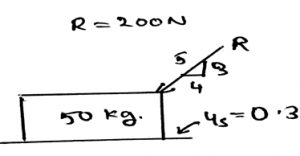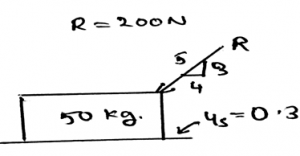This set of Engineering Mechanics Multiple Choice Questions & Answers (MCQs) focuses on “Problems Involving Dry Friction”.
1. In the simplification of the forces for the free body diagram, the net force acts at the ___________ of the loading body.
a) Centroid
b) The centre axis
c) The corner
d) The base
View Answer
Explanation: In the simplification of the loading system the net force acts at the centroid of the loading body. That is if the loading system is in the form of the triangle then the at the distance 2 by 3 of the base the net force of the loading will act. And the load will be half the area of the loading.
2. As in the determination of the various unknown forces in the free body diagram involves the use of vectors. So one of the vector law is commutative law and it is valid for the cross product of two vectors. (Commutative law: PxQ = QxP; for two vectors P and Q)
a) True
b) False
View Answer
Explanation: This statement is wrong. It is not possible unless we apply a negative sign to the RHS of the equation. That is PxQ = -(QxP). It is because, if you curl your wrist from one vector towards another vector, the thumb projected will give the direction of the cross product. Thus if you reverse the direction, the negative sign is necessary.
3. The frictional force developed always acts ____________ to the surface of the application of the friction.
a) Tangential
b) Perpendicular
c) Parallel
d) Normal
View Answer
Explanation: The friction is the phenomena that defines that there is a resistance which is present there between the two surfaces. This friction is applied tangentially to the surfaces in contact. Thus the main thing is that the forces on both of the surfaces act tangential to each other.
4. As the free body diagram of the problem statement involves the use of forces. So in them the ___________ forces do not cause the rotation.
a) Non-concurrent
b) Concurrent
c) Parallel
d) Non-Parallel
View Answer
Explanation: The concurrent forces are the one are somewhere touching the axis of rotation. If any of the force is touching that axis, that force is not considered or is insufficient to cause a rotation. If a force is concurrent then the perpendicular distance of the force from the line of the axis is zero, thus no rotation. As we know rotation is caused by a moment.
5. For equilibrium, the normal forces act in which direction in the free body diagrams if they are constructed for the friction part calculations?
a) Vertically Upward
b) Vertically Downward
c) Horizontally Right
d) Horizontally Left
View Answer
Explanation: As the loads are being acting in the downward direction. Thus to make the forces balance, the normal forces act in the vertically upward direction. As we know that when there is no lubricating fluid present between the surfaces in contact, the dry friction occurs. This friction magnitude is taken out from these normal forces.
6. Which of the following is the assumption on the property of the surface on which block is present in case we are dealing with the calculations involving the friction?
a) Non-rigid
b) Coloured red
c) Having density in negative
d) The motion of that block is always horizontal
View Answer
Explanation: The block used to explain the theory of friction is used in a deformable surface. As we know that the theory of friction says that when there is no lubricating fluid present between the surfaces in contact, the dry friction occurs. Thus to show the same experiments are done over a non-rigid/deformable surface.
7. There are three types of friction problems. One of them is _____________
a) Impending motion at a single point of contact
b) No-Impending motion at a single point of contact
c) Impending motion at all points of contact
d) Apparent Impending motion
View Answer
Explanation: There are mainly three types of friction problems. They are no-apparent impending motion, impending motion at all points of contact and impending motion at some points of contacts. Therefore the answer is impending motion at all points of contact. There is involvement of various types of calculations which is there in all of the three types.
8. The phenomena of horizontal pull and push explain something related to the friction, among the following what is it?
a) Theory of friction
b) Theory of relativity
c) Theory of action
d) Theory of forces
View Answer
Explanation: As we know that when there is no lubricating fluid present between the surfaces in contact, the dry friction occurs. This is the phenomena that defines that there is a resistance which is present there between the two surfaces. Thus the pull and push phenomena explain the theory of friction.
9. Calculate the Normal force developed between the body and the surface.
a) 611N
b) 116N
c) 100N
d) 180N
View Answer
Explanation: The net forces acting on the body is shown with the help of the resultant forces. There are two types, first the frictional and the second is normal. This is because the resultant forces have the sum of all the forces which are acting in the direction which is same.
10. There are mainly two types of forces which are being stated in the free body diagram, and they are generally the resultant of various forces which are being acted over the body. Which are they?
a) Normal and Frictional
b) Normal and Vertical
c) Vertical and Frictional
d) Normal and Fractional
View Answer
Explanation: The net forces acting on the body is shown with the help of the resultant forces. There are two types, first the frictional and the second is normal. This is because the resultant forces have the sum of all the forces which are acting in the direction which is same.
11. The frictional force is directly proportional to the surface of the solid.
a) True
b) False
View Answer
Explanation: The frictional force is directly proportional to the vertical forces that are being applied normal to the surface of the body. The force of friction is not dependent on the type of the surface. Thus the only thing the frictional force does depend is the normal force.
12. Calculate the frictional force developed between the body and the surface.

a) 160N
b) 16N
c) 10N
d) 180N
View Answer
Explanation: None.
Sanfoundry Global Education & Learning Series – Engineering Mechanics.
To practice all areas of Engineering Mechanics, here is complete set of 1000+ Multiple Choice Questions and Answers.
If you find a mistake in question / option / answer, kindly take a screenshot and email to [email protected]

